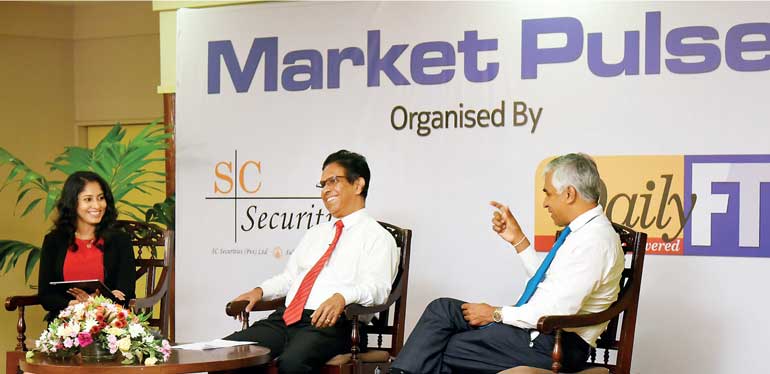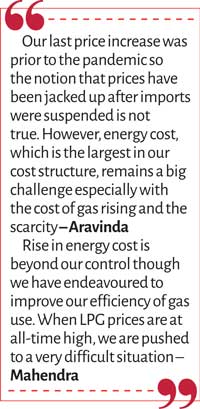Monday Mar 03, 2025
Monday Mar 03, 2025
Wednesday, 5 January 2022 00:00 - - {{hitsCtrl.values.hits}}

Lanka Walltiles Plc Managing Director Mahendra Jayasekera (right) and Royal Ceramics Lanka Plc Managing Director Aravinda Perera (centre) during the Daily FT-SC Securities organised “Market Pulse” interview done by SC Securities Assistant Manager Investment Banking and Marketing Dilusha Gamage – Pic by Ruwan Walpola
By Nisthar Cassim
The ceramic tiles and bath ware sector has seen a rebound in investor interest in the Colombo stock market. This is largely due to improved earnings potential of the sector after the Government imposed curbs on imports, especially on the tiles, as part of an overall strategy to save scarce foreign exchange reserves in the aftermath of the COVID pandemic as well as to boost local manufacturing industries.
Government imposed curbs on imports, especially on the tiles, as part of an overall strategy to save scarce foreign exchange reserves in the aftermath of the COVID pandemic as well as to boost local manufacturing industries.
The conscious strategy by the Government has paid off so far with the local producers who previously languished with 10 months of stocks, increasing their share of the market hitherto dominated by cheaper imports. Leading brands Lanka Walltiles Plc Group including Lanka Tiles Plc and Royal Ceramics Lanka Plc Group, claim that that current shortage experienced by customers would be temporary as the local industry is ramping up capacity as they could amidst limitations whilst the sector is also drawing interest from new local players. The two Groups are confident of Sri Lanka becoming self-sufficient in tiles and bath ware if the Government persists with the desired policy of encouraging local manufacturing.
The Daily FT-SC Securities Ltd., as part of its joint initiative “Market Pulse” recently met up with Lanka Walltiles Plc Managing Director Mahendra Jayasekera and Royal Ceramics Lanka Plc Managing Director Aravinda Perera to get key insights to the growth, challenges and opportunities in the sector. Here are excerpts of the FT TV interview conducted by SC Securities Assistant Manager Investment Banking and Marketing Dilusha Gamage:
Q: Give us a brief overview of the two Groups.
A: Aravinda – Royal Ceramics started as a manufacturer of tiles with a plant at Eheliyagoda. Thereafter we added another factory in Horana. In tandem with growth and future prospects, RCL acquired control of Lanka Ceramics Plc as well as Lanka Tiles Plc. Eleven years ago we diversified into manufacture of sanitary and bath ware.
Mahendra – Lanka Walltiles started in 1974. Its origin was interesting. An American firm sourcing tiles from Japan wanted to shift the latter to Sri Lanka. The Japanese plant was set up in Balangoda as a subsidiary of Ceylon Ceramics Corporation which was privatised in 1994 as Lanka Ceramic Ltd. Lanka Tiles was launched to produce tiles in 1984. Together we are the largest manufacturer of floor and wall tiles in Sri Lanka.
Q: Tiles sector shares have performed well in recent years prompting investor interest. How do you view this renewed interest?
Mahendra: To put things in proper perspective, before the pandemic the tiles companies were really struggling with as much as 10-months stocks as imports were invading the Sri Lankan market especially at lower price levels. There were times when we had to curtail our production. As a Group we had only 20% of the market. Imports catered to 60% of the market demand. However, post-pandemic, the Government decided to suspend imports in a bid to save foreign exchange. As a result, in FY21, we were able to bring down our inventory from 10 months to a month and today we are running into about three-weeks stocks or less. This is why the tile sector has seen phenomenal growth in profits sparking renewed investor interest. Going forward, whether we can achieve the same phenomenal growth is unlikely. This is because we are running our factories at full capacity and plans for expansion are limited.
three-weeks stocks or less. This is why the tile sector has seen phenomenal growth in profits sparking renewed investor interest. Going forward, whether we can achieve the same phenomenal growth is unlikely. This is because we are running our factories at full capacity and plans for expansion are limited.
Q: How is the industry managing the rising cost consequent to depreciation of the Rupee in earlier months, rise in freight and material cost, etc.?
Aravinda: Yes, these factors have pushed the cost up. Local and overseas suppliers too have increased their prices. When it comes to exports by Royal Ceramics, recently we couldn’t handle a single order due to lack of containers as well as ships. So, it is a double whammy in terms of uncertainty and rise in costs. In recent months we have taken a closer look at our cost structure whilst in the past five years we have been implementing cost reduction projects including energy saving, efficiency improvements, yield improvements, reduce waste, from the lowest operator upwards are involved in these initiatives. When it comes to bath ware products and tiles, our last price increase was prior to the pandemic so the notion that prices have been jacked up after imports were suspended is not true. However, energy cost, which is the largest in our cost structure, remains a big challenge especially with the cost of gas rising and the scarcity.
Mahendra: Rise in energy cost is beyond our control though we have endeavoured to improve our efficiency of gas use by about 10-15%. Lanka Tiles is the single largest industrial user of LPG in the country with a requirement of over 1,000 metric tons per month and RCL is over 800 metric tons. When LPG prices are at all-time high, we are pushed to a very difficult situation. The entire ceramics industry is using most up-to-date technology and there is little room to drive up energy efficiency. 
Aravinda: The high inventory of 8-10 months stocks prior to the pandemic cost the companies dearly in terms of working capital apart from cost of running warehouses, etc. However, post-pandemic improved cash flows helped us to reduce our debt apart from the benefit of lower interest rates.
Q: How have the margins performed?
Aravinda: If we are to maintain the profit margins as they are we need to produce more and sell more whilst ensuring we keep our costs low or satisfactory level.
Q: Due to import restrictions there is a severe shortage. Is there room to further boost capacity?
Mahendra: There isn’t much room. Total tiles market used to be about 30 million square metres per annum. Due to the pandemic the market has dropped to about 24 million square metres. The existing three manufacturers supply is about 20 million square metres which means there is a 20% shortage. For the time being we are unable to fill this gap. At LTL we are running at full capacity which is at 20,000 square metres per day and have plans to expand the capacity by 4,500 square metres by July 2022.
Expansions in the tile sector have long gestation periods and cannot be done overnight. The third player has already undertaken expansion and that capacity would enable to address part of the shortage too. So overall, availability of tiles in the market will improve in the short to medium term. Whether we will double our capacity in the long term is unlikely as I can’t foresee such a development since it is very challenging.
Aravinda: Sri Lanka Ceramics and Glass Council undertook a study where we looked at capacity and expansion plans of three tile manufacturers and four manufacturers of bath ware. This report has been shared with the Government. We appreciate the Government decision to curtail tile imports and we have assured the Government that when all expansion projects are completed by July or August 2022 the current market demand can be met entirely by local producers. Major expansion in bath ware will only happen if the market demand sees high growth on a sustainable basis as well as if prospects for exports improve. Whilst tiles import is restricted, sanitary ware isn’t. A more definitive policy will weigh heavily in favour of a major expansion. We also understand that there are several more local companies who are looking at entering the market.
Q: How are expansions being financed?
Mahendra: Mostly via internally generated funds. There is no major requirement for debt or equity financing because our cash flows have improved.
Q: How do you see future growth when considering the iconic port city project, several upcoming mixed developments and condominiums?
Aravinda: Yes, Port City is iconic and if the requirements of all its projects come at the same time, then there will be a big issue. We hope the development and resultant demand will be on a staggered basis. However, such projects also enjoy special facilities for imports. 
Mahendra: These new mixed developments are welcomed as it will raise the quality of products required. LTL Group monthly production is 600,000 square metres or 6 million square feet of tiles. RCL production is very close to that. In that context the tile industry cannot sustain itself unless there is domestic construction, especially village level housing development. People should be spending their disposable income in improving their homes and constructing new homes.
Q: What are the prospects for exports?
Mahendra: LTL is the largest exporter of tiles from Sri Lanka. LTL is the only export brand in the global market with the word “Lanka” as part of its name. We export to the US, Australia, Japan among others. I agree our export potential is immense. In 2019, we took a big step forward in our exports drive. In August 2019, the US imposed anti-dumping levies on 2,000 products from China and one was Ceramic Mosaic tiles. Soon after we entered into a tripartite JV involving US and Chinese firms and us to set up a dedicated plant to manufacture this product. This is now operational and its entire production is exported to the US.
Whilst there are great export opportunities Sri Lanka needs to select the right product. The industry must also go up in the value chain to become competitive and garner more exports as well as fight the import ban, which won’t be long term or permanent. In the past LTL used to sell tile in the global market at an average price of $ 6 or $ 7 a square metre. On the other hand, the mosaic product we sell between $ 15 to 30 per square metre. This confirms the premium for value addition.
Aravinda: Our tile exports are limited but bath ware we export 20% of our production. We have more demand from our buyers but we can’t service all of it since there is a bigger demand in the local market. We have begun to sharpen our export focus as previously given the high inventories, we were selling all what we had locally. We ventured into exports only when we had difficulty in the local market due to the flood of cheap imports.
Q: What is RCL and LTL response to the 25% one off tax surcharge on corporate profits?
Aravinda: The method of calculation is still not clearly known. Once clarified we have no choice but to pay. However, the tax will have an impact on our expansion plan to meet local demand as we were planning to use internal funds for it.
Mahendra: On the basis of the wording in the Budget, the impact on LTL will be Rs. 600 million.
Q: If import restrictions were to be lifted on tiles what kind of setback will it be?
Aravinda: The import restrictions have been only for two years so far. Before that, we survived despite the struggle. We will endeavour to be resilient in the future too. We have seen costs rising in import-source markets such as China.
Q: What prospects for the next five years?
Mahendra: LTL and Lanka Ceramics: The medium-term prospects will depend on the policy framework. In the meantime, we will expand our capacity in a limited way through Lanka Walltiles thereby improving its profitability. If and when imports are resumed, a proper tariff structure is important. If not, we will find the market more challenging. Sri Lanka was and will continue to be finding it difficult to be globally competitive when it comes to tiles manufacturing. LTL once ran seven factories in India in 2018 and imported their output amounting to 1,500 containers to Sri Lanka. To a supplier from Italy, we paid Rs. 70 per kilo in India due to the economies of scale whereas for the same supply we paid Rs. 100 per kilo in Sri Lanka. Same with machinery.
Therefore, Sri Lanka’s cost composition is very different to other locations. They also have massive advantages when operating as manufacturing bases. So, it is a misconception to argue that if India produces at this price, why not Sri Lanka too. Prospects and expansions in the next five years will heavily depend on the Government policy. If the present status quo remains, LTL will be in for good times. The only headwind is supply chain disruptions including suppliers being unable to open or execute LCs given the foreign exchange shortage in Sri Lanka.
heavily depend on the Government policy. If the present status quo remains, LTL will be in for good times. The only headwind is supply chain disruptions including suppliers being unable to open or execute LCs given the foreign exchange shortage in Sri Lanka.
Aravinda: As far as RCL is concerned, yes cost matters. At the same product differentiation such as design can play a role. We also have to ensure operations remain lean and mean so that we continue to compete and make profits. We are committed to that like in the past.
Discover Kapruka, the leading online shopping platform in Sri Lanka, where you can conveniently send Gifts and Flowers to your loved ones for any event including Valentine ’s Day. Explore a wide range of popular Shopping Categories on Kapruka, including Toys, Groceries, Electronics, Birthday Cakes, Fruits, Chocolates, Flower Bouquets, Clothing, Watches, Lingerie, Gift Sets and Jewellery. Also if you’re interested in selling with Kapruka, Partner Central by Kapruka is the best solution to start with. Moreover, through Kapruka Global Shop, you can also enjoy the convenience of purchasing products from renowned platforms like Amazon and eBay and have them delivered to Sri Lanka.
Discover Kapruka, the leading online shopping platform in Sri Lanka, where you can conveniently send Gifts and Flowers to your loved ones for any event including Valentine ’s Day. Explore a wide range of popular Shopping Categories on Kapruka, including Toys, Groceries, Electronics, Birthday Cakes, Fruits, Chocolates, Flower Bouquets, Clothing, Watches, Lingerie, Gift Sets and Jewellery. Also if you’re interested in selling with Kapruka, Partner Central by Kapruka is the best solution to start with. Moreover, through Kapruka Global Shop, you can also enjoy the convenience of purchasing products from renowned platforms like Amazon and eBay and have them delivered to Sri Lanka.